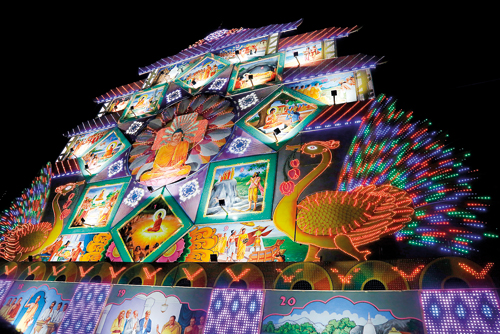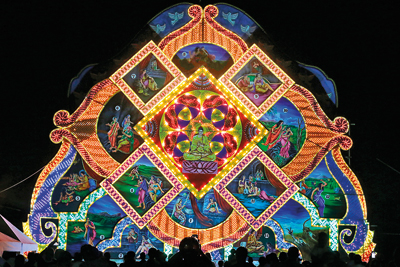Digitalised pandals flash bright this Vesak

Peliyagoda pandal: Combining tradition and new technology. Pix by M.A. Pushpa Kumara
Over the past few years, Vesak pandals and other decorations illuminating the city have seen new technology making its presence felt with digital printing and laser and pre-programmed lighting systems. Technology has even allowed Vesak pandals to occupy cyberspace.
In the past years, we have seen how pandals have evolved– aluminium pipes being used for the scaffolding instead of the customary arecanut trunks or bamboo. These were reused unlike arecanut trunks that had to be disposed of after one Vesak.
Usually Vesak pandals with myriad flashing lights are illuminated through what is called a flasher roll.
The light pattern variations of a flasher roll system depend on the circumference of the flasher roll. The time that takes the flasher roll to rotate a full round determines the pattern switching speed of the pandal. When the roll completes a full rotation, the pattern is repeated.

Dematagoda pandal: Combining flasher roll technology and digital technology
Touring Colombo, we find the Peliyagoda pandal is a fusion of tradition and new technology. The illustrations of the pandal are hand drawn but the additional decorative patterns are printed digitally. The colourful images are illuminated using LED bulbs which are connected with wires to a unit that operates the pandal according to a pre-written computer code, explains Dimuthu Rukmal Warusawithana. The electronic light designs of the Peliyagoda pandal show his creativity.
Costing less than Rs. 1000 to run the display per day, the digital LED pandal is energy efficient, said E. Rajapaksha, the manager for this pandal erected by the Nawaloka Group of Companies. A traditional pandal would have an electricity cost of about Rs. 300,000 to be illuminated for several days, he added.

The old: The flasher roll system (above) and the new: The digitalised circuit system (right)
However, there is a downside to the digital pandal. The construction of a digital pandal is more complex and a thorough knowledge of electronics and programming is needed, explained Dimuthu. If a circuit board gets exposed to the rain the entire pandal may stop working. But while a traditional pandal can only go for a set of basic colours through LED lights you can get as many colours as you want.

Nilantha Rukshan: In charge of the pandal at Mulgandhakuti Viharaya, Welisara
The Dematagoda pandal combines flasher roll technology and digital technology. Nimantha Kavinda working under his brother Sangeeth Madushan’s guidance to illuminate the pandal with LEDs powered by an integrated circuit system had written the programme for it in less than a month. Compared to the flasher roll system, the digital system takes up less space, said Nimantha. The rotation of the flasher roll produces a loud noise which the music accompanying the pandal and the narration drowns out but a digital system is noiseless.
At a glance, the lights on the Dematagoda pandal look like a traditional pandal with 5 watt bulbs but multiple LEDs are contained inside the bulb cup create the effect that a 5 watt bulb does.
Although the developments in technology have provided more alternatives to the traditional way of

Dimuthu Warusawithana: Man behind the creative designs of the Peliyagoda pandal
constructing a pandal, this does not seem to be holding back those who still follow the traditional way of lighting up pandals.
The Vesak pandal at Mulgandhakuti Viharaya, Welisara with hand drawn illustrations, is lit using traditional flasher roll technology and 25,000 5-watt bulbs, said Nilantha Rukshan who is in charge of the pandal’s construction. He estimates the cost at around Rs. 1.1 million. The new additions are incapable of reaching the level of artistic beauty that traditional pandals have, he feels.
“We prefer to use the analogue flasher roll technology because it poses less risk of system failures,” said Nimal Wansalogus, President of the Sri Waishakhaloka Society which is responsible for the construction of the Thotalanga Pandal. Since the circuit connects entire rows of bulbs together, one bulb malfunctioning would make the entire row of bulbs go off. Fixing errors in an analog system is easier than in a digital system, he added. With a traditional pandal as long as the flasher roll can be rotated the pandal would function with minimal issues.


